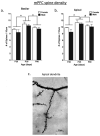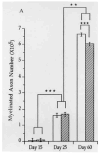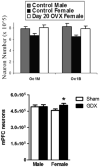Pubertal onset as a critical transition for neural development and cognition
- PMID: 27060769
- PMCID: PMC5053848
- DOI: 10.1016/j.brainres.2016.04.012
Pubertal onset as a critical transition for neural development and cognition
Abstract
Adolescence, broadly defined as the period between childhood and adulthood, is characterized by a variety of neuroanatomical and behavioral changes. In human adolescents, the cerebral cortex, especially the prefrontal cortex, decreases in size while the cortical white matter increases. Puberty appears to be an important factor in both of these changes. However, the white matter continues to grow beyond what is thought to be adolescence, while the gray matter of the cortex stabilizes by young adulthood. The size changes that are the manifestation of cortical reorganization during human adolescence are also seen in cellular reorganization in the rat cortex. The prefrontal cortex loses neurons, dendrites and synapses while myelination in the white matter continues to increase. All of this reorganization is more marked in female rats, and there is evidence both from pubertal timing and from removal of the ovaries that puberty plays an important role in initiating these changes in females. The maturation of behavioral functions of the prefrontal cortex, such as inhibitory control, occurs in both humans and rats across adolescence. There is also evidence for puberty as a major factor in decreasing perseveration in rats, but few studies have been done using pubertal status as an experimental variable, and the role of the gonadal steroids in modulating behavior throughout life makes clear effects more difficult to document. In all, puberty appears to be so essential to the changes occurring during adolescence that it should be recorded when possible, especially given the sex difference in pubertal timing. This article is part of a Special Issue entitled SI: Adolescent plasticity.
Keywords: Adolescence; Inhibitory control; Neuron number; Prefrontal cortex; Puberty.
Copyright © 2016 Elsevier B.V. All rights reserved.
Conflict of interest statement
The authors have no conflicts of interest to report.
Figures





References
-
- Andersen SL, Thompson AT, Rutstein M, Hostetter JC, Teicher MH. Dopamine receptor pruning in prefrontal cortex during the periadolescent period in rats. Synapse. 2000;37:167–169. - PubMed
-
- Andrzejewski ME, Schochet TL, Feit EC, Harris R, McKee BL, Kelley AE. A comparison of adult and adolescent rat behavior in operant learning, extinction, and behavioral inhibition paradigms. Behav Neurosci. 2011;125(1):93–105. - PubMed
-
- Aubele T, Kritzer MF. Androgen influence on prefrontal dopamine systems in adult male rats: localization of cognate intracellular receptors in medial prefrontal projections to the ventral tegmental area and effects of gonadectomy and hormone replacement on glutamate-stimulated extracellular dopamine level. Cereb Cortex. 2012;22(8):1799–1812. - PMC - PubMed
-
- Bartzokis G, Beckson M, Lu PH, Nuechterlein KH, Edwards N, Mintz J. Age-related changes in frontal and temporal lobe volumes in men: a magnetic resonance imaging study. Arch Gen Psychiatry. 2001;58(5):461–465. - PubMed
Publication types
MeSH terms
Grants and funding
LinkOut - more resources
Full Text Sources
Other Literature Sources
Medical

